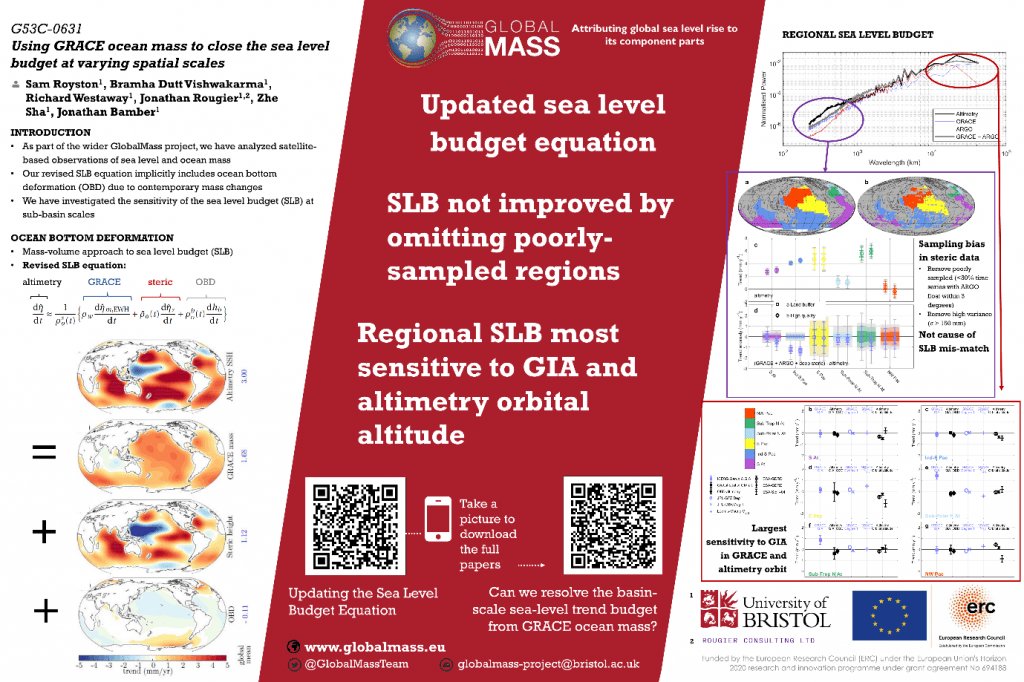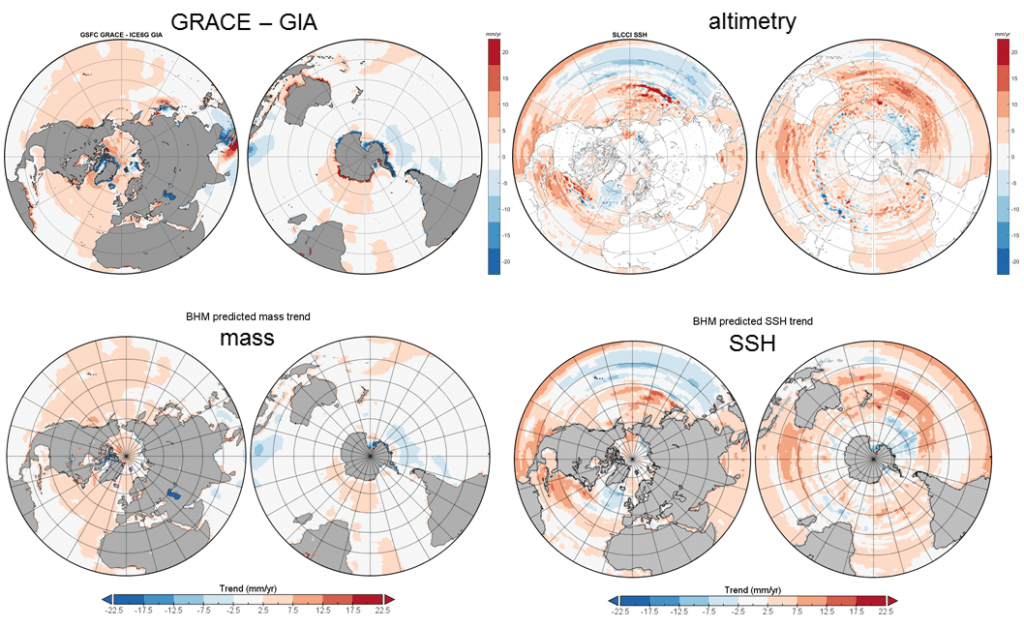Oceans
Progress (December 2019)
Many of the research activities we have undertaken during 2019 can be grouped together as analyses of satellite-based observations of sea level and ocean mass linked to the global sea level budget.
The global sea level budget is a ‘balance-sheet’ approach for identifying and correctly accounting for all the factors that contribute to sea level rise and provides an important check on the accuracy of observational datasets. In practice it involves comparing measured ‘total’ change in sea surface height change (derived from satellite radar altimetry) with the sum of its component parts, namely measured changes in ocean density (from the network of Argo floats) and ocean mass (from the Gravity Recovery and Climate Experiment, or GRACE, satellite mission).
With over 11 years of very-high quality density and mass observations at good spatial scale, the sum of the parts approaches the total within known uncertainty at a global scale. We have shown, however, that if we examine the sea-level budget at the ocean basin scale, we find significant discrepancies that are difficult to explain, and which persist despite different processing and averaging methods. Specifically, we have found that ocean density measurements do not seem to include small spatial scales that sea surface height measurements do record. Rather than this mismatch averaging out over larger spatial scales, which we expect if the errors are random, it leads to differences in ocean basin averages. We have also uncovered a mismatch at the hemispheric scale, which we believe comes from the way the satellite measurements are processed.
In parallel to these analyses, we have also been working to update and improve the sea level budget equation itself. The conventional sea level budget equation sums mass and density terms but does not include elastic ocean bottom deformation, implicitly assuming it is negligible. However, in recent decades and in large part due to increased ice melt from ice sheets, changes in ocean mass have overtaken density change as a component of sea level rise. Therefore, ocean bottom deformation (OBD) – vertical movement in the ocean floor because of the extra weight of ocean water – can no longer be assumed to be negligible. We have derived a revised sea level budget equation from fundamental physical principles that explicitly includes an OBD term, ensuring that that it is acknowledged as an increasingly important sea level process. We have also tested the revised sea level budget equation with observational data to suggest that OBD is at least as important as deep-ocean volume changes for determining trends in global mean sea level.

Figure 1: Our poster presented at AGU Fall Meeting 2019
Finally, given the known uncertainties associated with ‘direct’ measurements of ocean mass, we have investigated using the global ocean salt budget as an alternative approach. In other words, we have used the observed ‘freshening’ of the global oceans to infer the mass change that must have occurred in order to produce it. This gives an ocean mass trend that is smaller than some other previous estimates, but one which potentially a useful independent validation of trends calculated from GRACE.
Progress (November 2018)
We have previously reported that an estimation of a steric sea level change signal (i.e. sea level change due to variations in water density, primarily thermal expansion) would be the first real test of the BHM framework on a global scale. Several iterations later and we are still analysing whether the results tell us more about large-scale steric trends or the quality and reliability of the observational data used…
Since the initial results, we have tested and improved various aspects of the experimental set-up including:
(i) which version of the Gravity Recovery and Climate Experiment (GRACE) data we use;
(ii) how non-stationery processes (those that do not tend towards a constant long-term average or spread through time) are represented; and
(iii) how we correct for glacial isostatic adjustment (GIA).
Exploring these aspects has shown us that the Bayesian Hierarchical Framework (BHM) is operating as it should and increased our confidence in the steric results it produces (figure below) and, as a global average, our steric results are now close to observational estimates (from Argo floats).

Comparison of observed (top) and BHM-predicted (bottom) trend in ocean mass (left) and sea surface height (right) for the period 2005-2015. For each pair of plots, the trend value is given in the left-hand map and the trend error in the right-hand map.
However, significant discrepancies continue to occur at a regional to local scales. As we are confident that the BHM is replicating observations, the implication is that signals at these scales are not well represented in the observational datasets (GRACE, Argo and/or altimetry). Deeper analysis of the different observational datasets has thus become an ongoing focus.
Progress (April 2018)
Our initial work investigated the global salt budget study to understand if we could use it to improve estimates of ocean mass trends.
Next, as part of BHM framework development, we are in the process of estimating steric sea level trends (due to temperature and salinity) for 2005-2015 on a global scale. Based on observations and prior knowledge about trends in sea surface height (SSH; from altimetry), GIA (from the ICE-6G forward model) and ocean mass (from GRACE), the residual SSH signal (i.e. altimetry minus mass) should reflect steric changes. We will compare our solution with four established ‘steric trend’ gridded datasets to assess their performance, focusing on basin-scale trends and under-sampled ocean areas such as polar regions.
Next page: Outputs
